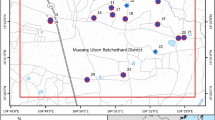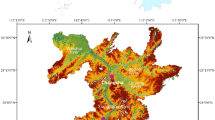Abstract
Drinking water is a main source of human exposure to arsenic. Hence, the determination of arsenic in groundwater is essential to assess its impact on public health. Here, we report arsenic levels in the groundwater of 722 sites covering all six major provinces of Korea. Water was sampled in two occasions (summer, 722 sites and winter, 636 sites) and the arsenic levels were measured with highly sensitive inductively coupled plasma-mass spectrometry method (limit of detection, 0.1 μg/l) to encompass the current drinking water standard (<10 μg/l). Seasonal variation was negligible, but the geographical difference was prominent. Total arsenic in groundwater ranged from 0.1 to 48.4 μg/l. A 88.0–89.0% of sites were <2.0 μg/l and the remaining ones generally did not exceed 10 μg/l (6.4–7.0%, 2.0–4.9 μg/l; 2.4–3.0%, 5.0–9.9 μg/l). However, some areas (1.0–9.2%) exhibited >10 μg/l. Notably, urinary arsenic excretion of people around these regions was markedly higher compared with non-contaminated areas (<5 μg/l) (79.7±5.2 μg/g (N=122) vs 68.4±5.4 μg/g (N=65) creatinine, P=0.052). All stratified analysis also revealed higher urinary excretion, where a statistically significant difference was noted for non-smokers (85.9±12.7 vs 54.0±6.3, P=0.030), suggesting that arsenic-contaminated groundwater may contribute to its systemic exposure.
This is a preview of subscription content, access via your institution
Access options
Subscribe to this journal
Receive 6 print issues and online access
$259.00 per year
only $43.17 per issue
Buy this article
- Purchase on Springer Link
- Instant access to full article PDF
Prices may be subject to local taxes which are calculated during checkout


Similar content being viewed by others
References
Halder D, Bhowmick S, Biswas A, Chatterjee D, Nriagu J, Guha Mazumder DN et al. Risk of arsenic exposure from drinking water and dietary components: implications for risk management in rural Bengal. Environ Sci Technol 2013; 47: 1120–1127.
WHOArsenic and Arsenic Compounds, 2nd edn. Environmental Health Criteria 224. World Health Organization: Geneva, Switzerland, 2001.
Hughes MF, Beck BD, Chen Y, Lewis AS, Thomas DJ . Arsenic exposure and toxicology: a historical perspective. Toxicol Sci 2011; 123: 305–332.
Le XC, Cullen WR, Reimer KJ . Determination of urinary arsenic and impact of dietary arsenic intake. Talanta 1993; 40: 185–193.
Berg M, Tran HC, Nguyen TC, Pham HV, Schertenleib R, Giger W . Arsenic contamination of groundwater and drinking water in Vietnam: a human health threat. Environ Sci Technol 2001; 35: 2621–2626.
Guha Mazumder DN . Chronic arsenic toxicity: clinical features, epidemiology, and treatment: experience in West Bengal. J Environ Sci Health A 2003; 38: 141–163.
Nordstrom DK . Public health. Worldwide occurrences of arsenic in groundwater. Science 2002; 296: 2143–2145.
Smith AH, Lingas EO, Rahman M . Contamination of drinking-water by arsenic in Bangladesh: a public health emergency. Bull World Health Organ 2000; 78: 1093–1103.
Naujokas MF, Anderson B, Ahsan H, Aposhian HV, Graziano JH, Thompson C et al. The broad scope of health effects from chronic arsenic exposure: update on a worldwide public health problem. Environ Health Perspect 2013; 121: 295–302.
Wu M-M, Kuo T-L, Hwang Y-H, Chen C-J . Dose–response relation between arsenic concentration in well water and mortality from cancers and vascular diseases. Am J Epidemiol 1989; 130: 1123–1132.
Yoshida T, Yamauchi H, Fan Sun G . Chronic health effects in people exposed to arsenic via the drinking water: dose–response relationships in review. Toxicol Appl Pharmacol 2004; 198: 243–252.
ASTDR. The Priority List of Hazardous Substance. Agency for Toxic Substances and Disease Registry, US Department of Health and Human Services, Public Health Service: Atlanta, GA, USA. 2013.
EPA Implementation Guidance for the Arsenic Rule: Drinking Water Regulations for Arsenic and Clarification to Compliance and New Source Contaminants Monitoring. United States Environmental Protection Agency: Washington DC, USA. 2002.
Mandal BK, Suzuki KT . Arsenic round the world: a review. Talanta 2002; 58: 201–235.
Rodríguez-Lado L, Sun G, Berg M, Zhang Q, Xue H, Zheng Q et al. Groundwater arsenic contamination throughout China. Science 2013; 341: 866–868.
Taussky HH . A microcolorimetric determination of creatine in urine by the Jaffe reaction. J Biol Chem 1954; 208: 853–862.
Lee Y, Nelder JA, Pawitan Y . Generalized Linear Models with Random Effects: Unified Analysis via H-likelihood. CRC Press: Boca Raton, FL, USA. 2006.
McArthur J, Ravenscroft P, Safiulla S, Thirlwall M . Arsenic in groundwater: testing pollution mechanisms for sedimentary aquifers in Bangladesh. Water Resour Res 2001; 37: 109–117.
Smedley P, Kinniburgh D . A review of the source, behaviour and distribution of arsenic in natural waters. Appl Geochem 2002; 17: 517–568.
Ahn J-S, Ko K-S, Chon C-M. Arsenic Occurrence in Groundwater of Korea. J Soil Groundw Environ 2007; 12: 64–72.
Nicolli HB, Bundschuh J, Blanco Mdel C, Tujchneider OC, Panarello HO, Dapena C et al. Arsenic and associated trace-elements in groundwater from the Chaco-Pampean plain, Argentina: results from 100 years of research. Sci Total Environ 2012; 429: 36–56.
Guha Mazumder DN, Haque R, Ghosh N, De BK, Santra A, Chakraborty D et al. Arsenic levels in drinking water and the prevalence of skin lesions in West Bengal, India. Int J Epidemiol 1998; 27: 871–877.
Tondel M, Rahman M, Magnuson A, Chowdhury IA, Faruquee MH, Ahmad SA . The relationship of arsenic levels in drinking water and the prevalence rate of skin lesions in Bangladesh. Environ Health Perspect 1999; 107: 727–729.
Tseng WP, Chu HM, How SW, Fong JM, Lin CS, Yeh S . Prevalence of skin cancer in an endemic area of chronic arsenicism in Taiwan. J Natl Cancer Inst 1968; 40: 453–463.
Armienta M, Segovia N . Arsenic and fluoride in the groundwater of Mexico. Environ Geochem Health 2008; 30: 345–353.
EPA Arsenic Occurrence in Public Drinking Water Supplies. United States Environmental Protection Agency: Washington DC, USA, 2000.
Martinez VD, Vucic EA, Lam S, Lam WL . Emerging arsenic threat in Canada. Science 2013; 342: 559.
Caruso RV, O'Connor RJ, Stephens WE, Cummings KM, Fong GT . Toxic metal concentrations in cigarettes obtained from U.S. smokers in 2009: results from the International Tobacco Control (ITC) United States survey cohort. Int J Environ Res Public Health 2014; 11: 202–217.
Navas-Acien A, Umans JG, Howard BV, Goessler W, Francesconi KA, Crainiceanu CM et al. Urine arsenic concentrations and species excretion patterns in American Indian communities over a 10-year period: the Strong Heart Study. Environ Health Perspect 2009; 117: 1428–1433.
Carbonell-Barrachina AA, Wu X, Ramirez-Gandolfo A, Norton GJ, Burlo F, Deacon C et al. Inorganic arsenic contents in rice-based infant foods from Spain, UK, China and USA. Environ Pollut 2012; 163: 77–83.
Wei Y, Zhu J, Nguyen A . Rice consumption and urinary concentrations of arsenic in US adults. Int J Environ Health Res 2014; 24: 459–470.
Wong WW, Chung SW, Chan BT, Ho YY, Xiao Y . Dietary exposure to inorganic arsenic of the Hong Kong population: results of the first Hong Kong total diet study. Food Chem Toxicol 2013; 51: 379–385.
Leffers L, Ebert F, Taleshi MS, Francesconi KA, Schwerdtle T . In vitro toxicological characterization of two arsenosugars and their metabolites. Mol Nutr Food Res 2013; 57: 1270–1282.
Author information
Authors and Affiliations
Corresponding authors
Ethics declarations
Competing interests
The authors declare no conflict of interest.
Rights and permissions
About this article
Cite this article
Park, JD., Choi, SJ., Choi, BS. et al. Arsenic levels in the groundwater of Korea and the urinary excretion among contaminated area. J Expo Sci Environ Epidemiol 26, 458–463 (2016). https://doi.org/10.1038/jes.2016.16
Received:
Accepted:
Published:
Issue Date:
DOI: https://doi.org/10.1038/jes.2016.16
Keywords
This article is cited by
-
As and \({\mathrm{F}}^{-}\) cooccurrence in drinking water: critical review of the international scenario, physicochemical behavior, removal technologies, health effects, and future trends
Environmental Science and Pollution Research (2022)
-
Exposure Levels and Contributing Factors of Various Arsenic Species and Their Health Effects on Korean Adults
Archives of Environmental Contamination and Toxicology (2022)
-
As(III) adsorption onto Fe-impregnated food waste biochar: experimental investigation, modeling, and optimization using response surface methodology
Environmental Geochemistry and Health (2021)
-
An Inter-disciplinary Approach to Evaluate Human Health Risks Due to Long-Term Exposure to Contaminated Groundwater Near a Chemical Complex
Exposure and Health (2020)



